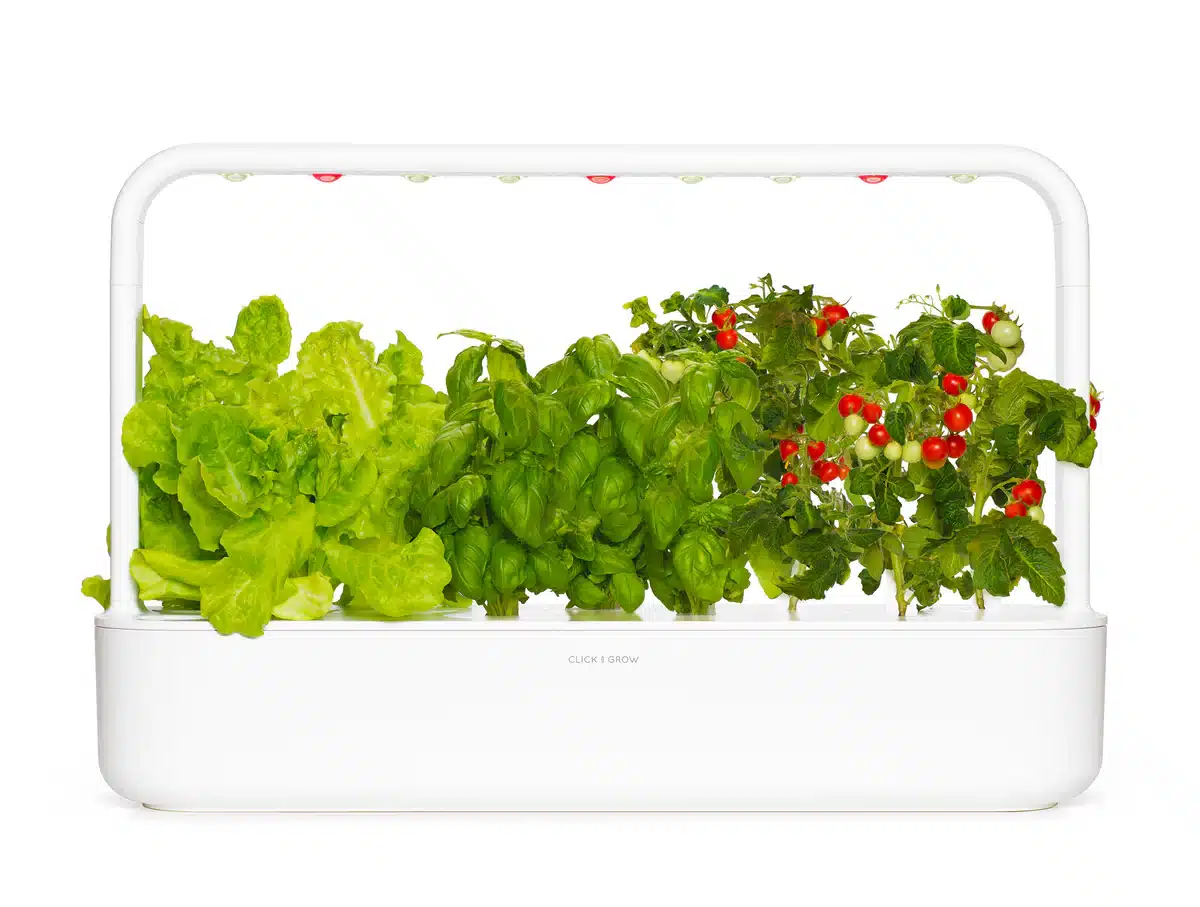Affiliate Disclosure:
Some of the links in this content are affiliate links, which means we may earn a small commission at no extra cost to you if you make a purchase through them. We only recommend products we truly believe in and think will bring value to our readers. Your support helps us continue creating helpful, sustainable content—thank you!
Table of Contents
Introduction: What Is a Smart Garden?
In today’s fast-paced world, finding time for gardening can be challenging. Yet, the desire to grow our own herbs, vegetables, or decorative plants remains strong, especially for those seeking a more sustainable lifestyle or a relaxing hobby. Enter the smart garden.
But what is a smart garden exactly?
A smart garden is a self-sustaining, technology-powered gardening system that automates plant care. It typically uses sensors, IoT (Internet of Things) technology, and app connectivity to monitor and manage essential aspects like lighting, watering, and nutrients, making gardening easy and accessible, even for those with no experience.
This guide will break down everything you need to know about smart gardens, including how they work, their benefits, types, top models, and how to start your smart home garden.
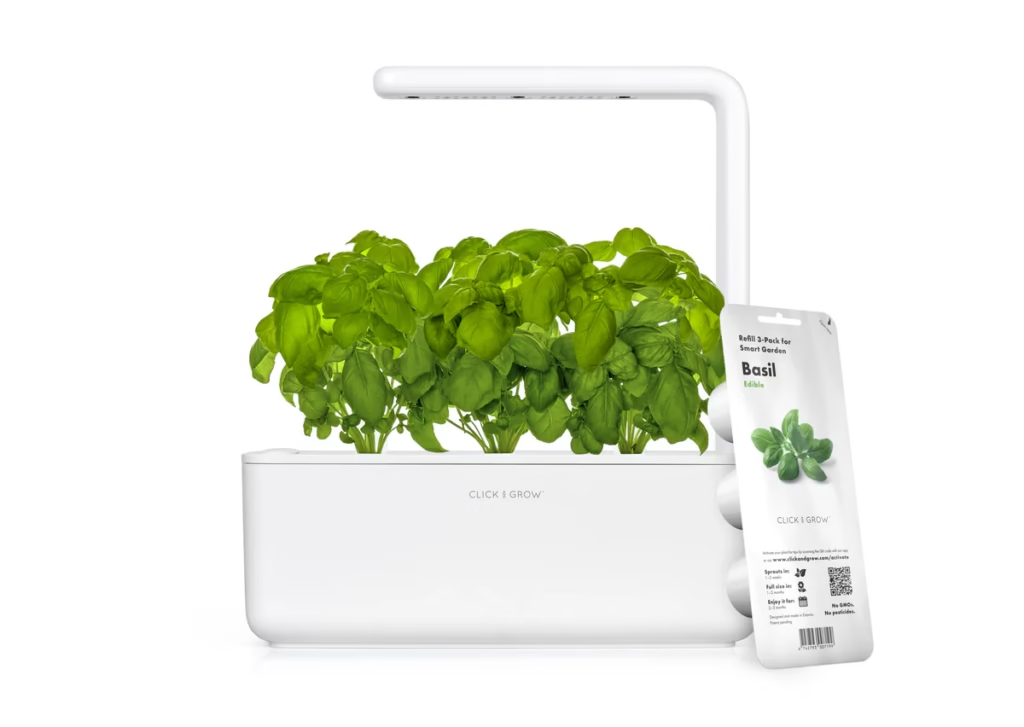
The Smart Garden 3
The perfect garden for growing herbs and flowers all year round.
Chapter 1: Understanding Smart Gardening
What Is a Smart Garden?
A smart home garden is a high-tech version of traditional gardening that automates plant care using intelligent systems. These systems often include:
- Automatic watering
- Smart lighting (LED grow lights)
- Climate control
- App or voice control via smartphone or smart home devices
- Nutrient delivery systems
- Sensors to monitor soil moisture, temperature, humidity, and light
In essence, smart gardens eliminate guesswork from gardening and allow plants to thrive in controlled environments—whether it’s a small herb garden on your kitchen counter or a hydroponic tower in your living room.
Chapter 2: Key Features of a Smart Garden
To fully understand what a smart garden is, it’s important to explore its core features:
i Automatic Watering
Most smart gardens are equipped with a self-watering system that supplies the correct amount of water at the right intervals. Moisture sensors often trigger this function based on real-time data.
ii. LED Grow Lights
Smart gardens come with energy-efficient LED grow lights that mimic natural sunlight. These are often programmable or adaptive, adjusting intensity and duration based on plant needs.
iii. Soil and Environmental Sensors
Sensors constantly monitor:
- Soil moisture
- Ambient temperature
- Humidity
- Light intensity
This data feeds into the system to optimize plant care, adjusting water and light as necessary.
IV. Mobile App Integration
Users can control their garden via apps that:
- Send real-time updates
- Track plant growth
- Notify when to add nutrients
- Suggest plant-specific care tips
v. Compact and Modular Design
Smart gardens are designed for small spaces. Some are desktop-sized, while others are modular systems that can be expanded vertically or horizontally.
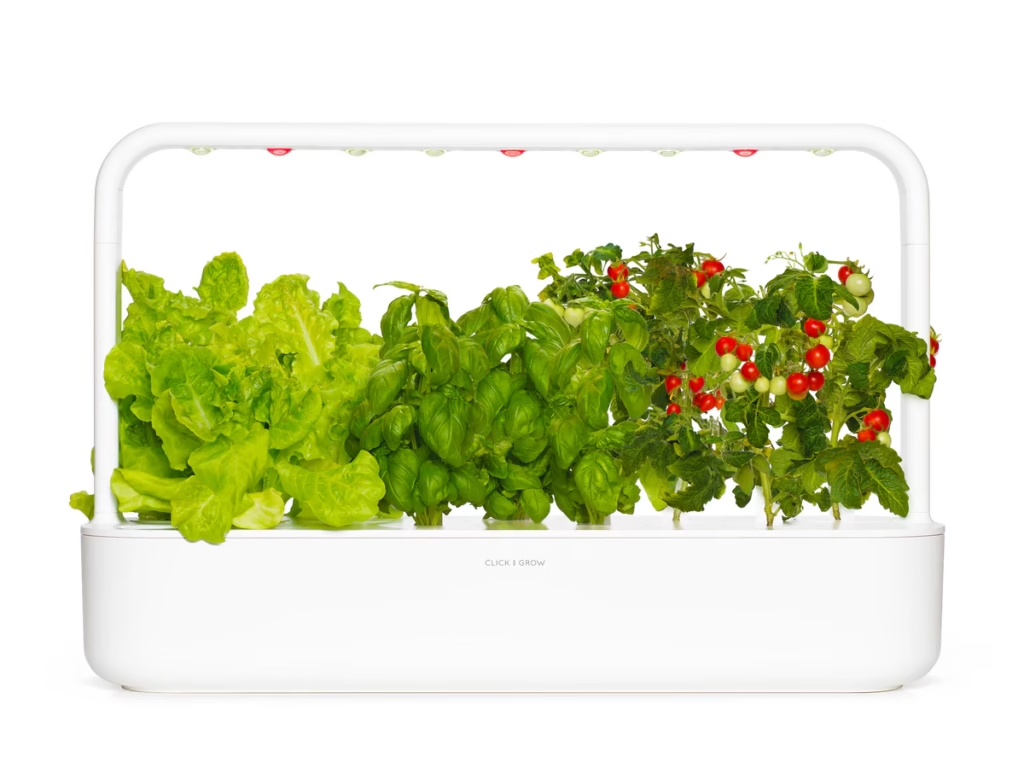
The Smart Garden 9
The Smart Garden 9 is a self-growing indoor garden that lets you grow fresh, organic herbs, fruits, salads, and flowers—no matter where you live. It handles watering, light, nutrients, and oxygen for you, and the companion app helps you grow like a pro. Choose from 75+ plant pods or use your seeds. Includes 3 tomatoes, 3 basil, and 3 lettuce pods (yellow tomatoes may replace red). Start growing fresh, healthy plants at home
Order your Smart Garden 9 today!
Chapter 3: Types of Smart Gardens
Smart gardens come in various types, based on functionality, size, and planting method.
i. Indoor Smart Herb Gardens
- Ideal for kitchens and small apartments
- Grow basil, mint, parsley, and other culinary herbs
- Example: Click and Grow Smart Garden 3
ii. Hydroponic Smart Gardens
- Soil-less system that uses nutrient-rich water
- Faster growth rates and less mess
- Example: AeroGarden Harvest Elite
iii. Outdoor Smart Gardens
- Use weather sensors, irrigation systems, and automation
- Great for lawns, flower beds, and vegetable gardens
- Example: Gardena Smart System
IV. Smart Garden Pods or Towers
- Vertical gardening systems
- Save space while maximizing plant yield
- Example: Lettuce Grow Farmstand
Chapter 4: Benefits of Smart Gardening
i Low Maintenance
One of the primary benefits is ease of use. Once set up, smart gardens require minimal input. The system handles watering, lighting, and monitoring, so even a busy person can maintain a flourishing garden.
ii. Year-Round Gardening
Smart home garden are not bound by seasons. With LED lighting and indoor-friendly setups, you can grow food 365 days a year, regardless of the weather.
iii. Efficient Resource Use
By using sensors and data-driven automation, smart gardens conserve water and energy. This makes them more eco-friendly than traditional gardening methods.
iv. Healthy and Organic Produce
Grow your own herbs, vegetables, and even fruits without pesticides. You control everything, from the seed to the harvest.
v. Stress Reduction and Mental Health
Gardening is known to reduce stress and improve mood. Smart gardening adds this benefit without the hassle, making it perfect for urban dwellers.
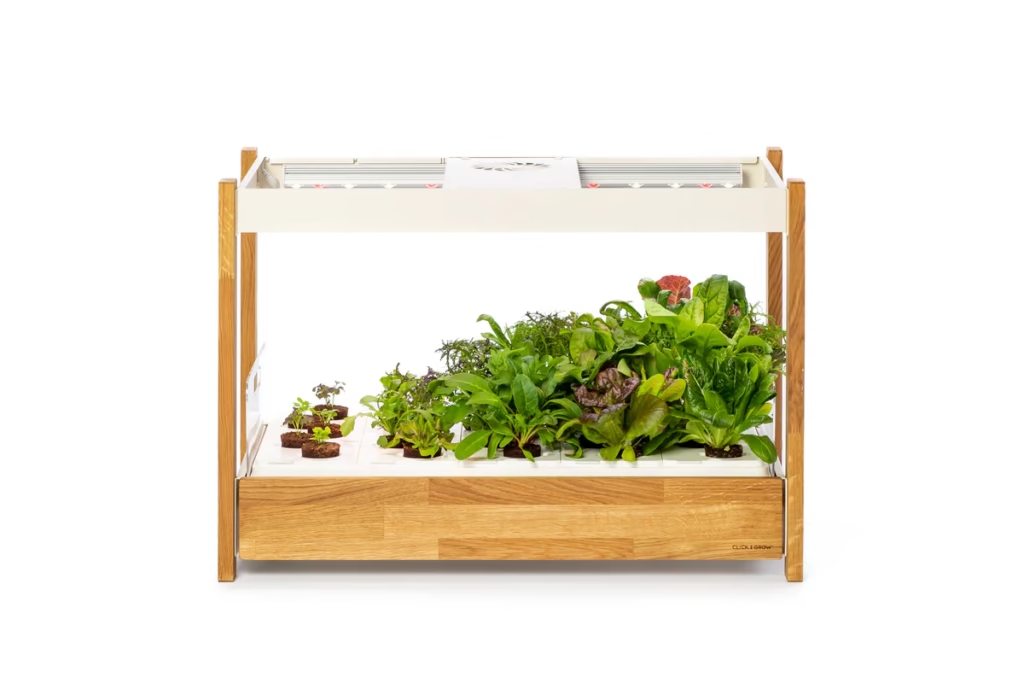
The Click & Grow 25
The Click & Grow 25 is a smart indoor garden designed for growing fresh, nutritious leafy greens year-round. It handles watering, lighting, and nutrients automatically, while the app tracks plant growth and offers helpful tips. Its patented tray system allows continuous planting and harvesting—insert pods on one end and harvest from the other. The sleek oak and metal design includes app-controlled lights, a humidity sensor, and add-on compatibility. The starter kit includes 54 plant pods (Green Lettuce, Romaine Lettuce, Red Kale). Best for greens, while herbs, fruits, and flowers are better suited for other Smart Gardens.
Chapter 5: Popular Smart Garden Brand and System
The recommended smart garden brand is Click and Grow due to its ease of use, reliable technology, and stylish design. It’s perfect for beginners and busy individuals who want to grow fresh herbs, vegetables, or flowers indoors with minimal effort. The system uses Smart Soil, built-in LED lighting, and a self-watering tank to create the ideal growing environment, making gardening as simple as inserting a pod and adding water. Whether you choose the compact Smart Garden 3 or the larger Smart Garden 9, Click and Grow delivers consistent, pesticide-free harvests year-round.
Related Post: Urban Cultivator Commercial Review: Transform Your Menu with Fresh Herbs Grown In-House
Chapter 6: Starting Your Own Smart Garden
Step 1: Choose Your Space
Decide where you want your smart garden—kitchen counter, balcony, or a corner in your living room. Make sure there’s access to power.
Step 2: Pick the Right Smart Garden System
Choose based on:
- Space available
- Plants you want to grow
- Your budget
- Desired level of automation
Step 3: Install and Set Up
Follow the manufacturer’s instructions. Most come pre-assembled or with simple assembly steps.
Step 4: Add Seeds or Pods
Some smart gardens use proprietary pods (like Click and Grow), while others allow seed customization.
Step 5: Monitor via App
Install the companion app. You’ll receive:
- Notifications for refills
- Tips for harvesting
- Growth tracking
Step 6: Harvest and Enjoy
Many herbs and greens are ready within 2–4 weeks. Smart gardens make it easy to harvest and replant.
Chapter 7: What Can You Grow in a Smart Garden?
Common Plants:
- Herbs: Basil, mint, cilantro, thyme
- Leafy Greens: Lettuce, spinach, arugula
- Vegetables: Cherry tomatoes, chili peppers
- Fruits: Strawberries (in larger systems)
- Flowers: Petunias, marigolds, lavender
Smart garden systems usually come with compatibility guides to ensure your plants grow optimally.
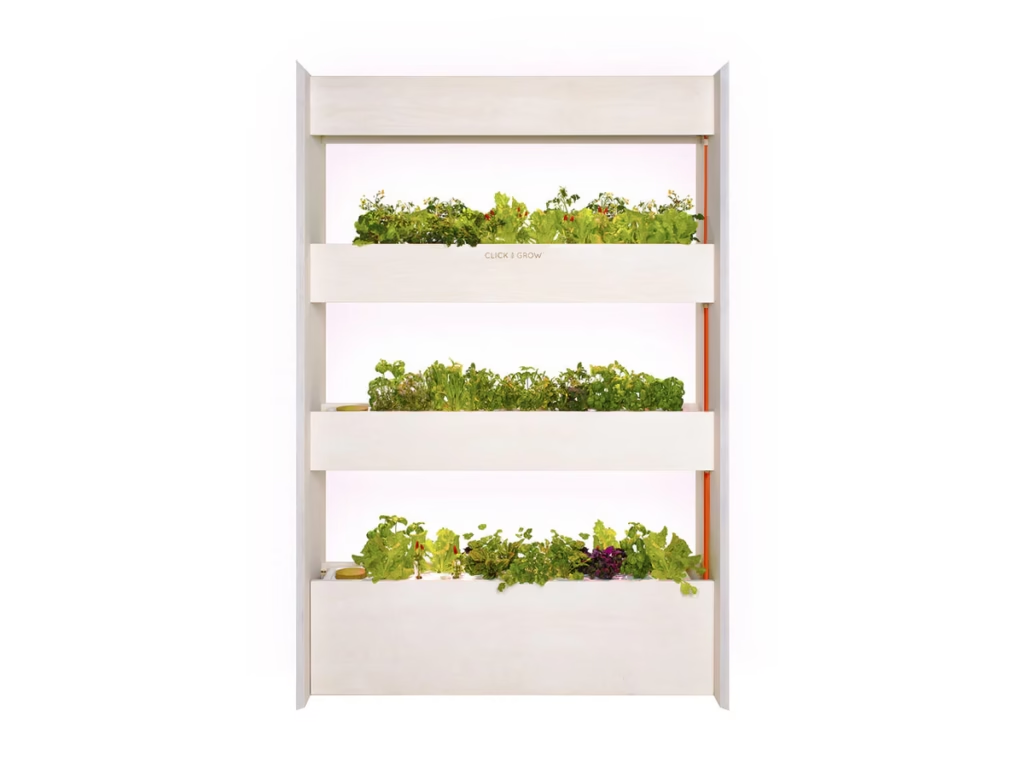
The Wall Farm Indoor Vertical Garden
The Click & Grow Wall Farm is a smart indoor vertical garden that lets you grow 51 herbs, fruits, and leafy greens year-round, right at home or in any space like offices, schools, or restaurants. It features three fully-equipped shelves with automatic watering and grow lights, powered by Click & Grow’s Smart Soil technology. The starter kit includes 54 plant pods across six themed mixes—from salad greens to tea herbs. The Wall Farm ships in three boxes: shelves, hardware, and plants—for easy setup and continuous fresh harvests.
Chapter 8: Smart Garden vs. Traditional Garden
| Feature | Smart Garden | Traditional Garden |
|---|---|---|
| Watering | Automated | Manual |
| Lighting | Artificial grow lights | Natural sunlight |
| Soil | Often soilless | Soil-based |
| Monitoring | App + Sensors | Manual checks |
| Learning Curve | Beginner-friendly | Requires knowledge |
| Space | Compact, indoor | Needs outdoor space |
Smart gardens are a practical solution to growing food sustainably for busy people or those in small homes.
Chapter 9: Cost of a Smart Garden
Initial costs can range from $80 to $500, depending on size and brand.
Ongoing Costs:
- Nutrient solutions or pods
- Replacement lights (after 1–2 years)
- Water (minimal)
Despite the cost, many users find the convenience, health benefits, and savings on grocery herbs and veggies worth the investment.
Also Read: 10 Creative Ways to Use Fresh Herbs for Restaurants and Transform Your Menu
Chapter 10: Future of Smart Gardening
Smart gardening is expected to grow rapidly with the advancement of:
- AI and machine learning in plant health monitoring
- Integration with smart home systems (Alexa, Google Home)
- Sustainable materials and solar-powered systems
- Community-based smart garden apps for social sharing
With urban populations rising and climate concerns growing, smart gardens represent a sustainable, tech-forward food production and wellness solution.
Conclusion: Is a Smart Garden Right for You?
So, what is a smart garden?
It’s the perfect blend of nature and technology. Whether you’re a city dweller looking to reconnect with nature, a busy professional wanting fresh herbs, or a sustainability enthusiast building a greener lifestyle, smart gardens make it easier than ever.
They remove the intimidation of traditional gardening, provide fresh produce year-round, and offer a rewarding, educational, and even therapeutic experience.
If you’ve been asking yourself, “What is a smart garden, and should I try one?”—the answer is a confident yes.
Final Thoughts
If you’re ready to get started, here’s a checklist:
– Choose your Smart home garden space
– Pick a beginner-friendly smart garden model
– Download the companion app
– Start with easy plants like basil or lettuce
– Enjoy a greener, healthier lifestyle—right from your home

